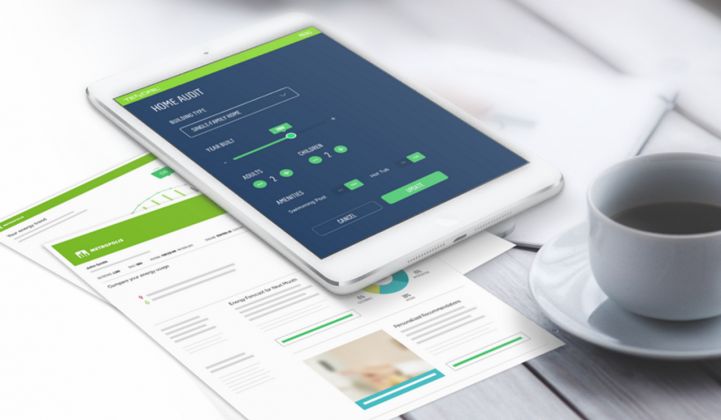Home energy management firm Tendril has been on the hunt for acquisitions since it landed a major investment from private equity firm Rubicon Technology Partners. Last week, it named its first purchase — EEme, a Pittsburgh-based startup that says its energy disaggregation technology can differentiate various household loads from a single electric meter’s data.
Financial terms of the acquisition were not disclosed. But Tendril, which monitors roughly 123 million U.S. homes and works with five of the top 10 U.S. utilities, said that the combination of EEme’s highly accurate disaggregation technology and its own household energy data analytics and modeling capabilities creates the largest-scale non-intrusive load monitoring solution on the market, moving the entire field of appliance detection forward.
"Appliance-level disaggregation holds great potential in helping people reduce their home energy consumption, but to be effective we must improve the accuracy and reliability of these solutions,” said Chris Black, Tendril's chief operating officer, in a statement. “With the acquisition of EEme we are enhancing our device-usage detection capabilities with highly complex technology that has been rigorously tested by third parties and validated by us over the past 18 months with 10 terabytes of [advanced metering infrastructure] data. Now when combined with the Tendril Platform, we will finally unlock the value of delivering appliance-level energy insights.”
Energy disaggregation, also referred to as non-intrusive load monitoring or NILM, is a broad term for many different types of approaches to sussing out individual loads and appliances from whole-home energy data that are being pursued by university spinouts, Silicon Valley startups and major technology companies. Some of the big players in the space include Bidgely, which works with large U.S. and European utilities and claims more than 10 million homes under contract, and PlotWatt, which has concentrated on commercial buildings and was acquired by American Efficient in November. Other disaggregation efforts we’ve covered over the years include Smappee, Neurio (formerly Energy Aware), Navetas, Belkin and Intel.
In general, the more granular the original whole-home data, the more accurate the disaggregation results. Systems that use hourly or 15-minute smart meter data tend to deliver roughly accurate projections of large household loads like air conditioning, heating, lighting and major appliances. Systems that use sensors to track and analyze the electricity flowing through the home’s circuits itself can deliver much better accuracy and capture a wider variety of appliances and devices — although they may still require a homeowner’s assistance in determining what’s what.
Tendril highlighted four reasons why it chose to acquire EEme out of a long list of potential NILM targets. First are its “state-of-the-art” machine-learning algorithms, such as “custom-built hidden Markov models,” developed at Carnegie Mellon University. Second, its cloud-based API can be integrated with Tendril’s platforms to scale to terabytes of AMI data, important for managing Tendril’s massive flow of data from the homes it serves.
Third, EEme is one of the only NILM providers to have conducted a publicly available third-party evaluation of how accurate its technology actually is in a real-world environment, Tendril noted. That evaluation was in 2015 with Pecan Street, the Austin, Texas-based research consortium that’s networked and sensored hundreds of homes to test solar panels, batteries, smart thermostats and appliances, EV chargers and other grid edge devices.
EEMe CEO and founder Enes Hosgor told Greentech Media in 2015 that its Pecan Street tests broke new ground for the energy disaggregation industry in terms of the scale and openness of its testing. “If you don’t have that insight in public, you cannot have a benchmark, a reference point, to move the entire knowledge base forward,” he said.
Chris Black at Tendril agreed with that sentiment in a statement on the EEme acquisition. Utilities have long been active partners in testing and deploying NILM technologies in the field, “but as standalone technologies, they often drive customer complaints due to false positives,” he said. “This may sound like a small concern, but the moment a customer questions the veracity of the reported energy usage, they question everything and their trust has been lost. We’ve heard this over and over from our utility customers that have tested NILM solutions in the past, so we really wanted to take our time and bring a unique approach to the market.”
Tendril laid out a number of use cases for EEme’s technology within its own home energy monitoring and analytics platforms:
- Identifying new EV owners, then communicating a personalized offer for a time-of-use rate and a recommendation to charge during lower-cost off-peak hours.
- Identifying HVAC systems that are becoming less efficient over time, then presenting a home energy report that focuses on AC load reduction, as well as personalized offers for HVAC repairs and rebates.
- Identifying cyclic loads such as pool pumps, then scheduling the AC unit so it doesn’t run at the same time as the pump, thus avoiding coincident peaks.




